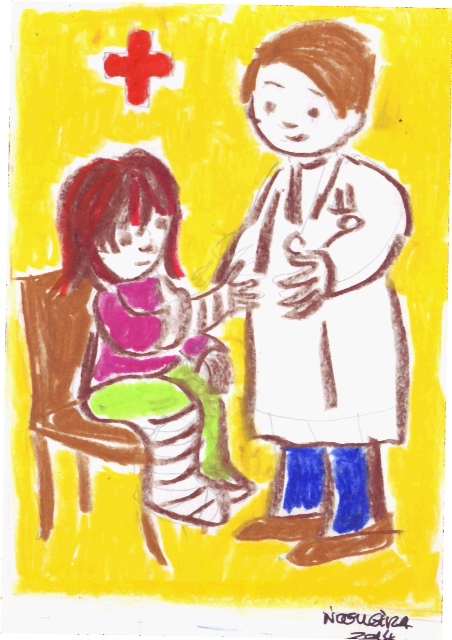The Swiss Health Care System

Sometimes, when I mention the Swiss health care system to friends back in the U.K., I get a comment about euthanasia or assisted suicides. These sorts of remarks are unfortunate, but perhaps not entirely surprising. Stories continue to pop up in the media about people travelling to Switzerland for the sole purpose of ‘suicide tourism’, an unnervingly gruesome-sounding term.
How much did you know about the Swiss health care system before you moved here? Have you finally gotten to grips with how everything works?
Getting used to the health care system in Switzerland can be a big shock for many expats. Even though Switzerland is regarded as having one of the best health systems in the world, it can still be difficult to navigate simply because it’s different to what you’ve previously been familiar with.
Anxiety and uncertainty
Over time, I’ve heard friends and acquaintances discuss all sorts of uncertainties that they’ve faced since moving to Switzerland. Some examples of health-related situations include the following: dreading the arrival of a large bill for health care costs, inability to buy certain medicines over-the-counter at a pharmacy, puzzlement over why bills for consultations get broken down into five-minute sections (with different prices for the first five minutes, the last five minutes, and the various minutes in-between), bewilderment that dental problems aren’t considered to be part of basic health care insurance, raised eyebrows over the positive encouragement of herbal tea-drinking in babies, detesting the common use of stirrups in gynaecological situations, anxieties over the price of an ambulance, and not knowing whether reminders will be sent in the post (for cervical screening, routine check-ups, vaccines, etc.).
Perhaps you are able to identify with some of these circumstances. Or perhaps these types of concerns seem rather pointless to you. It’s true to say that none of these are exactly difficult situations. But the fact remains: uncertainty around accessing health care can be extremely anxiety-provoking when you don’t know how things work. We need to feel comfortable with health care and health care providers. We are often at our most vulnerable (be that physically or emotionally) when we’re trying to access health care. And the simple fact that we just don’t know how the system works can cause a huge amount of stress (more so if we are trying to negotiate in a language we are not wholly fluent in). Dealing with the cultural changes and expectations in health care can be major stumbling blocks to deal with, and the uneasiness created should not be underestimated.
Helpful Guidance
A good basic guide in English for all newcomers to Switzerland is the Health Guide to Switzerland by Swiss Red Cross 2011 which you can order by post, or download online.
Another more comprehensive guide which explains exactly what compulsory basic health insurance covers is a guide from the Federal Office of Public Health, Your Questions, Our Answers. The Compulsory Health Insurance in Switzerland 2012. It’s definitely worth downloading this PDF. It’s a long read but helps to demystify the ins and outs of health insurance in Switzerland.
High costs
Some of the differences compared to your own health care system back home are down to costs. The Swiss health system is one of the most expensive in the world, with spending here being higher than the average spent by many other countries. The prices of prescription drugs are some of the highest in Europe. Spending on generic drugs (see note below) is a lot lower than many other countries. Switzerland has a higher number of doctors and nurses too. Switzerland also has one of the highest out-of-pocket costs for health care – this is individual spending on health care that doesn’t come from health insurance companies or Government funding, but straight out of our own pockets. Having mentioned cost, it’s also worth noting that around one third of Swiss residents receive subsidies when it comes to paying for basic health care insurance.
Complementary and Alternative Medicine (CAM)
An aspect of Swiss health care that some expats find intriguing is the availability of a wide range of complementary and herbal medications in pharmacies. Switzerland has more registered practitioners of complementary and alternative medicine (CAM) per head of population than anywhere else in the world. Switzerland is not unique in having CAM covered (or partially covered) by health insurance, but in general, the regulations around CAM are not that well established in Europe. In fact, Switzerland was the first country in Europe to integrate CAM into its health care system.
From 1999 to 2005, a number of complementary therapies were covered by compulsory basic health insurance (if the service was provided by a certified doctor). However, this coverage was stopped in 2005. Then in 2009, around two-thirds of the Swiss electorate voted in favour (under the Swiss system of deciding issues by referendum) of allowing complementary therapies to be covered by basic compulsory health insurance.
Switzerland is currently in the midst of an important evaluation process to see if CAM should continue to be covered by compulsory basic health insurance. Since 2012, five types of complementary medicine have been available via the basic health insurance system, if carried out by an appropriately-certified doctor. These five complementary therapies are as follows: homeopathy, herbal medicine (phytotherapy), neural therapy, traditional Chinese medicine, and anthroposophic medicine. This availability will continue until the end of 2017.
Although CAM medicine is popular in Switzerland, there is a lot of conflict about whether basic health insurance should actually cover it or not. After the end of 2017, the outcome of independent investigations into the effectiveness of CAM will be known. Whether CAM should be an integral part of the Swiss health care system is certainly a topic which attracts strong opinions. Under Swiss law, only medical services that are ‘effective, appropriate and efficient’ are allowed on the list of treatments that get reimbursed via the basic health insurance scheme.
Whether basic insurance coverage for complementary and alternative medicine will go on beyond the end of 2017 is likely to create lots of interest internationally.
By Dr Jahura Hossain
Born and brought up in London, Jahura is a U.K.-qualified doctor. She has worked in hospitals, general practice, public health, prison medicine, and the pharmaceutical industry.
© Copyright. Jahura Hossain. 2014. All rights reserved. No part of this article may be reproduced without the express consent of the author.
Illustration by Albina Nogueira
Albina has been a primary school teacher since 1992, and a writer and illustrator since 2006. She currently lives in Switzerland, but her homeland is Portugal. She is also the author of Letters to Grandparents and Hairdresser. To find out more, like her on Facebook or see her books in Amazon.
Some notes about this article:
Generic drugs – These are drugs without brand names and are generally cheaper in price. They contain the same active ingredient as more expensive drugs with brand names.
Facts and figures – If you are interested in more detailed figures about Swiss health care costs, and statistics about health care in Switzerland, get in touch and I’ll direct you to the information sources I looked at.
Complementary and alternative medicine (CAM) – This refers to a broad set of health care practices that are not part of a country’s own tradition or conventional medicine, and are not fully integrated into the dominant health care system of a particular country. (This is based on the World Health Organisation’s definition of complementary medicine).
Basic compulsory health insurance – Every person in Switzerland with basic compulsory health insurance pays a monthly premium to the insurance company of their choice. This premium varies depending on your insurer and the canton where you live. If you need medical treatment, you still have to pay part of the costs yourself. The amount you have to pay depends on your ‘deductible’ and the ‘retention fee’. The ‘deductible’ (also called ‘franchise’) is the amount that you have to pay towards your treatment costs every year (children up to the age of 18 do not pay a deductible). Your insurance company pays out once you get above your deductible amount. But even after your deductible has been exceeded, you still have to pay 10% of any treatment costs. This is called the ‘retention fee’ and is capped so you don’t pay more than a certain maximum each year.
Supplementary health insurance – This is entirely separate from basic compulsory health insurance. Supplementary health insurance can be taken out by individuals depending on their own wishes. It covers health services not covered by compulsory basic health insurance. Lots of CAM therapies are covered under various supplementary health insurance packages. Your own health insurance company can give you more details.
Useful websites concerning health care in Switzerland:
www.priminfo.ch – This lists all current premiums by health insurance providers (in German, French and Italian).
http://www.doktor.ch – This lists all doctors, dentists, clinics, hospitals, etc. in Switzerland. You can search by canton.
www.doctorfmh.ch – This provides a list of all members of the Swiss Medical Association (known as the FMH). Over 95% of doctors in Switzerland are members of this association. You can search for doctors by specialty, including doctors with recognised qualifications in different CAM therapies.



